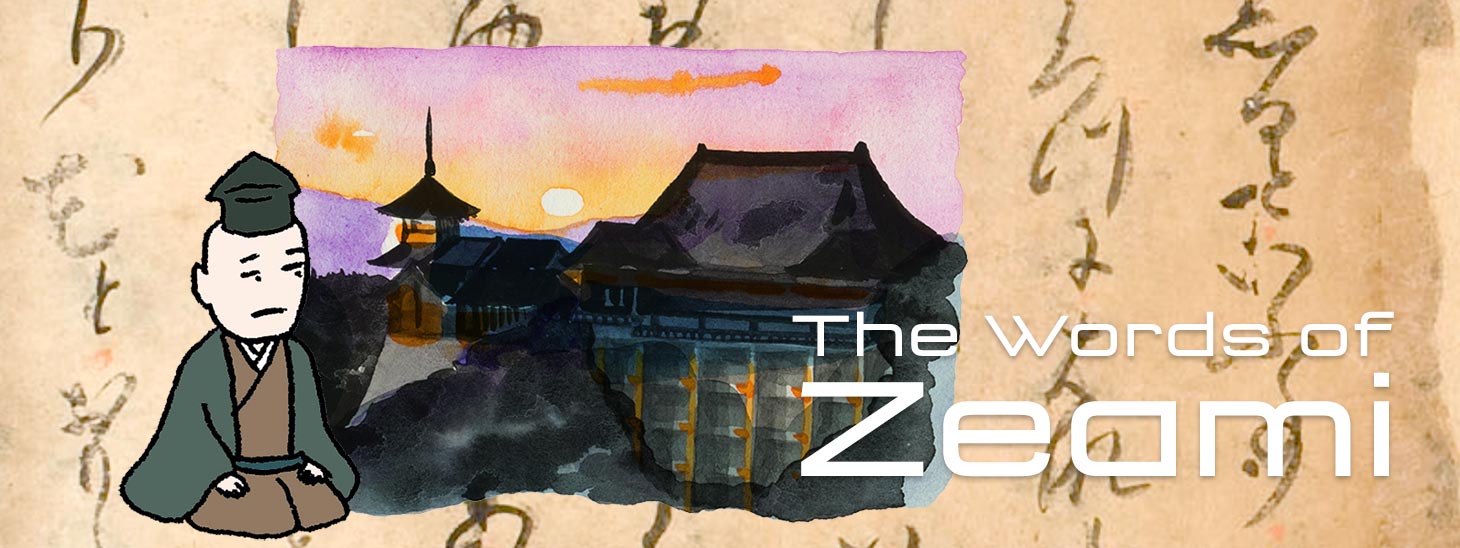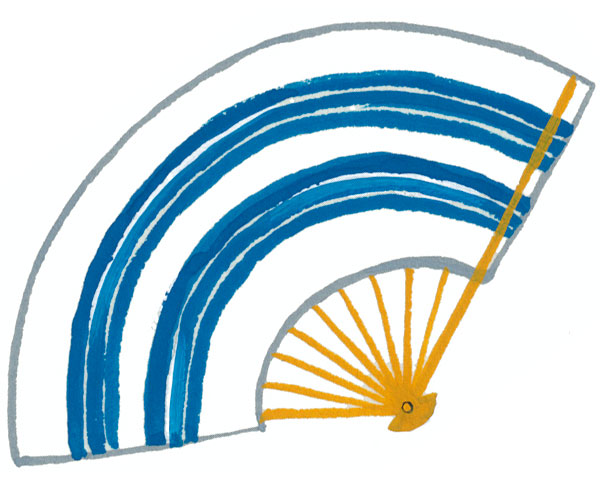
 |  |  |
| | Home | The Words of Zeami | Seven Stages of Life |
 Seven Stages of Life
Seven Stages of Life

The first chapter of “Fūshi kaden” is called “Nenrai keiko jōjō.” This chapter was originally intended to show instructions for Noh practice for each age bracket. It passed down to his successors as to what reactions should be taken suitable for each stage of a human’s life and for coping with aging. This chapter, however, also includes his comments, as an educator and a parent, about how we should interact with those of tender years and how we ought to age. There are full of Zeami’s insights about education and life.
Childhood (Around seven years old)
“In Noh art, a child starts to practice around seven years old. During the practice in these ages, you should respect what comes out naturally from the child and let him proceed as his heart tells him since he has natural beauty and attractiveness within his motions. He will lose his interest in Noh if you say his performance was good or bad and even worse if you rebuke him.”
Zeami showed his idea that parents should lead their children only by giving directions to solicit their voluntary interests. If parents strictly limit their children’s own initiatives, the children will simply become the clone of the parents and never exceed the level of the parents. Zeami’s suggestion is highly insightful.
Early Juvenile Age (From twelve or thirteen years onward)
Zeami gave the greatest praise to boys of twelve or thirteen years of age because they naturally embody the subtlety and profoundness in their beautiful boyish appearance and voice. However, such subtlety is only a "temporary flower" and not a genuine one. Zeami therefore warned that even if an actor appears wonderful in his youth, it does not necessarily guarantee his future success.
It is, therefore, important for a Noh actor to continuously practice without being deluded by the beauty he possessed in his youth.
Later Juvenile Age (From seventeen or eighteen years onward)
Zeami wrote that an actor experiences the first difficulty in his life at this stage of his life. “He loses his first flower because his voice breaks.”
In Noh art, they recognize a “flower” within the appearance and voice of early youth. Therefore, the later juvenile age, when a Noh actor experiences a physical change in the breaking of the voice and loses his loveliness, is recognized as the first challenge.
How can he overcome this adversity? Zeami mentioned that “even if people laugh at you, do not be bothered. Train yourself at your own pace, and practice aloud.”
”Entreat a god in your mind to fulfill your purpose. Acknowledge that this is the turning point of your life, so you can endure and do not abandon Noh. Setting your mind is the practice you can do. If you give up, your progress in Noh ends at this point.
A young Noh actor despairs of his future by facing an inevitable physical growth although both he and people around him think he is talented in it. However, this is the turning point of his life. His attitude of not giving up and of making efforts will help his life in the future.
If there is no progress while practicing within one’s own limits, endurance is necessary. If he despairs of acquiring skills, he fails to acquire the ability to overcome his limits. To keep practicing at his own pace will allow him to leap to the next stage.
Youth (Around twenty-four to twenty-five years old)

By this age, his voice has already broken, and he has physically matured and looks youthful and skillful. People sing his praises, and he might even beat skilled masters in competitions because people are curious about the young new performer. Anything new looks fresh. People highly praise him only for such a reason.
However, he might misunderstand such circumstances as he defeats the masters and begins to take himself for a master. Zeami severely criticizes such attitude as shameful.
‘If a Noh actor takes his popularity derived from his newness for real popularity, he goes far away from the “genuine flower.” It is the most unwise attitude if he does not notice that his popularity is temporary and he is conceited. When he gains popularity during his youth, he has to remember “shoshin (original intention)” and train harder.’
It is necessary to prepare for being a “makoto no hana (genuine flower)” while “jibun no hana (temporary flower)” is blooming.
Early Middle Age (Around thirty-four to thirty-five years old)
This is about the age when Zeami himself wrote “Fūshi kaden.”
Zeami said that if a Noh actor is not highly recognized by this age, he cannot be evaluated as a “genuine flower.”
“An actor can improve until thirty-four to thirty-five years old. After forty, he will just keep falling.” Therefore, it is necessary for a performer around this age to look back on his life and consider his future.
Around thirty-four to thirty-five years old, people face the moment for ascertaining how he or she is to live and which path to take in the future.
Late Middle Age (Around forty-four to forty-five years old)
“Yosome no hana mo shissuru nari (Others recognize that your blossom is falling).”
These are the words Zeami gave to those in this age bracket. Even for an actor who excels in the skills of Noh art, decay is inevitable, and the audience recognize that his “flower” is on the decline. If his flower does not fade in this age, he has a “genuine flower.” However, even so, an actor should not try overly difficult challenges but should focus on what he is good at.
Zeami recognized that the most important thing to do during this age is to train a successor. Since a person is still physically and mentally vigorous, it is the best time for a Noh actor to pass down his art to the next generation.
Zeami left a suggestion that an actor in this age should “give credit to the second shite” and he himself should perform modestly. This means that he has to give the credit to his successor and appear on the stage unobtrusively. “An expert knows himself and his limits.”
Old Age (After fifty years old)
Zeami described a Noh actor over fifty years old as in the final stage of his life.
When he completed “Fūshi kaden,” he was only thirty-six or thirty-seven years old. Therefore, it is said that he wrote this part while remembering his father, Kannami.
‘For a Noh actor who has lost his “flower” after he is fifty years old, the only way left for him is to do nothing special. It is an appropriate accomplishment as an old person. If he is a truly excellent Noh actor, his “flower” appears in such modest behavior.’
After this passage, Zeami mentioned Kannami’s Noh performance immediately before his death. Kannami dedicated a Noh performance at Sengen Shrine in Suruga fifteen days before his death.
”His Noh performance on the day was especially flowery. All the audience, both the upper and lower classes, praised his performance.”
“In Noh art, the flower keeps blooming even until a Noh actor becomes an old tree with few leaves and branches.”
Although Kannami’s dance was modest, with few movements, his accumulation of Noh art appeared as a remaining flower within his motionless performance. Zeami recognized that he had “perfected the form of art.” Even being aged, an old tree still has flowers. This is the ideal of Noh art for Zeami.
The seven steps of life Zeami described are the steps of decay and loss. A Noh actor loses the loveliness of his childhood, loses vigorous freshness in his young adulthood, and loses physical strength in his middle age. While losing something, a person treads the path of life. However, while the process of life is the loss of something, it is simultaneously the process of challenges to gain something new. In other words, it is the time for “shoshin (original intention).” “Shoshin wasuru bekarazu (remember your original intention)” can be interpreted as Zeami’s hope that his successors will continue taking on new challenges all their lives.